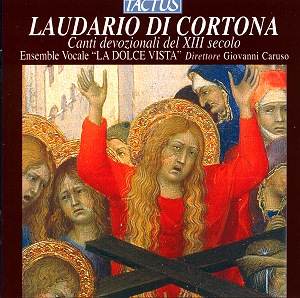One
of the most beautiful and powerful thirteenth century paintings
in the Uffizi in Florence is the Rucellai Madonna by Duccio.
It was commissioned in 1285 by a body called the Confraterniti
of the Laudesi of the Church of Santa Maria Novella. In Tuscany
and Umbria in the thirteenth century there grew up many groups
of what were usually called compagnie delle laude (‘lauda
companies’). Their activities extended well beyond the commissioning
of paintings. The compagnie delle laude were groups of
laymen - and sometimes laywomen - generally organised by the
Domenican and Franciscan friars, which met to do works of charity,
to listen to religious instruction and to take part in religious
ceremonies in which they sang laude (plural of lauda).
Laude were often sung in the evening in front of a statue
of the Virgin Mary. Their texts were, most often, in Italian
- since their singers would not generally have known Latin -
and are amongst the earliest poetic texts in Italian. Their
music was indebted to popular traditions. Blake Wilson’s book
of 1992, Music and Merchants: The Laudesi Companies of Republican
Florence, while it deals mainly with a later period than
the present CD, is full of useful information.
We
have some two hundred manuscripts containing the verbal texts
of laude. Most of the texts are anonymous, though there
are some by the important poet Jacapone da Todi. From the earlier
period, the time of the initial growth of the form, there survive
only two manuscripts which contain both verbal texts and
musical melodies of laude – Codice Banco Rari 18,
now in the Biblioteca Nazionale Centrale in Florence and Codice
91, belonging to the Biblioteca Comunale / Accademia Etrusca
in Cortona. The Florentine codex contains 89 laude with
melodies; the Cortona codex contains 46 laude with melodies.
Some 20 texts and 10 melodies appear in both manuscripts. The
Florentine manuscript is the later of the two and is rather
more elaborate, perhaps reflecting professional performance
practice. This fascinating CD contains performances of a selection
of material from Codice 91.
A
major problem is that the musical texts contain no mensural
indications insofar as rhythm is concerned. Nor, of course,
do they contain any guidance as to instrumentation. There are
competing theories as to what rhythmical practice should be
adopted. Account books of some of the compagnie delle laude
survive and record payments to musicians, to players of
the viol, harp etc.; such documents, along with the evidence
of contemporary paintings, make possible informed guesses as
to the kind of instrumentation which might be appropriate. Here
the instrumental accompaniment is provided – in various permutations
– by viol, harp, lute, recorder, cialamello (a shawm-like ancestor
of the oboe), tambourin de Béarn (a kind of string drum, often
called a tambourin à cordes) and miscellaneous percussion.
The vocal group, La Dolce Vista – their name taken, presumably,
from the ballata by Landini - is dominated by female voices.
The
results are often very beautiful, the rhythmic propulsion clear
without excessive emphasis, the interplay of voices and instruments
well judged. All the soloists sing attractively, though Dario
Polini’s tenor isn’t always quite as commanding as it might
be. The ensemble singing is generally very good and convincingly
idiomatic.
There
is perhaps just a bit too much polish and grace to the performances.
Much of this music must have been performed without scores and,
indeed, by people who couldn’t read music. Furthermore, the
compagnie delle laude have been seen as one of
the products of what has been called the religious hysteria
of mid-thirteenth century Italy. Their ceremonies sometimes
included self-flagellation. Heaven forbid that we should expect
modern performers to undertake such practices in the interests
of ‘authenticity’! But perhaps we might expect just a little
more abandon, a little less precise calculation, a little less
politeness, in the performance of laude such as these.
There
have been other recordings of some of the laude; I think,
however, that this is the first to be exclusively devoted to
materials from the Cortona MS.
The
booklet contains a useful essay – in Italian, English and French
– by Giorgio Monari and the Italian texts (but no translations).
Despite
my minor grumble about what I take to be the over-decorous nature
of these performances, this is a lovely recording of some fascinating
music. It makes a persuasive case for the performance strategies
that have been adopted – without doing anything to rule out
quite other approaches to the music. Warmly recommended.
Glyn Pursglove

![]() Ensemble
Vocale La Dolce Vista: Giulia Galasso (soprano), Angela Bucci (soprano),
Raffaella Siniscalchi (mezzo), Daniela Trailo (alto), Christine Steubühr
(alto), Dario Paolini (tenor)
Ensemble
Vocale La Dolce Vista: Giulia Galasso (soprano), Angela Bucci (soprano),
Raffaella Siniscalchi (mezzo), Daniela Trailo (alto), Christine Steubühr
(alto), Dario Paolini (tenor)![]() TACTUS TC 270001
[50:58]
TACTUS TC 270001
[50:58]